After my first duck hunt, I got hopelessly, completely, thoroughly addicted to it. If you haven’t had the opportunity to try it, and you’re looking for a new gun-related hole to throw money into, I highly recommend it. Like any outdoor endeavor, if you’re a good shot, you might actually harvest some game.
On the chance that you do, careful preparation of your kill is of supreme importance. Several people told me that wild duck wasn’t worth the effort. They were so wrong. So so wrong.
With that said, ducks taken over saltwater are a different breed than your typical farm raised or freshwater harvested quacker. They’ve been brining themselves from the inside out on salty marsh vegetables, and the occasional fish. Pretty much every hunting and cooking website I could find recommended roasting wild ducks whole unless they were shot over saltwater. At which point, most chefs threw up their hands and made the usual recommendations for less than stellar meat: “make it into sausage.”
As I usually do when I’m in a pickle as to how to prepare a piece of game, I turn to Hank Shaw at Honest Food. Hank’s not a personal friend, I’m just a loyal reader of his site. He produces a tremendous amount of content about preparing and eating wild game, and deep in the recesses of his site, he had a recommendation for how to deal with saltwater ducks: make them into pastrami. As the son of a New York immigrant, I’d grown up hearing about hot pastrami sandwiches, so my interest was piqued.
For the uneducated, pastrami encompasses any of the varieties of cured, smoked, and steamed products usually made from beef, pork, or turkey. You’ve most likely encountered a beef brisket prepared this way, served hot between two slices of rye with a good mustard. Maybe you added sauerkraut, Russian dressing, and some melted cheese. According to Wikipedia (of course), pastrami predates modern refrigeration (duh), and was a popular way of preserving meat, though it didn’t hit American shores until the wave of Jewish Romanians found their way to the good ol’ US of A in the late 19th century.
That Wikipedia article pushed me further towards making pastrami from my ducks with a notation that Jewish Romanians typically made pastrami from goose breast, but found beef navel to be much cheaper in America.
Famed traveling eater Anthony Bourdain once said, “Only Texans and Jews understand brisket.” Given that Texan brisket is sublime, Bourdain knows a thing or two about food, and by my reading of the transitive property, I figured that a traditional Jewish method of cooking must be good.
The process of making pastrami is actually quite simple assuming you can find the ingredients and have access to a device in which you can make smoke and hold a temperature at about 200 degrees. The whole process takes place over several days as the meat cures, but doesn’t really affect your day-to-day life much. And the results are totally worth it.
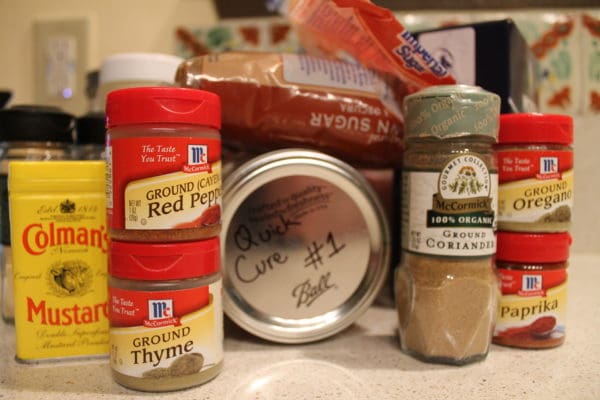
I combined two recipes for this project. The first, a goose pastrami, from Hank Shaw at Honest Food. The second, a duck breast pastrami, from Meatwave. Both recipes call for eating the final product straight from the smoker, or chilled and sliced. This deviates from the traditional cure, smoke, steam method which I believe is due to the water bath both recipes use to remove some of the saltiness. As such, purists might not consider either of these recipes a true “pastrami.” I don’t know enough about charcuterie to really argue the point.
The first step in the process is to ethically harvest your ducks. Mine were all redheads shot near Port Aransas, Texas. Like all game animals, getting them in the cooler fast never hurts, a problem that came up during phase two. My hunting buddy who took me on my inaugural duck hunt isn’t a huge fan of actually eating duck. Therefore, proper meat care wasn’t top of mind for him.
As a result, I ended up with some funky ducks. When I hunt next time, I’ll be sure to keep a cooler with ice on the boat so I can get them breasted and cooled quickly.
Mine had a distinctly gamey smell when I finally got them home and cleaned out. I left mine in the freezer for nearly three months to kill off any nasty microbes.
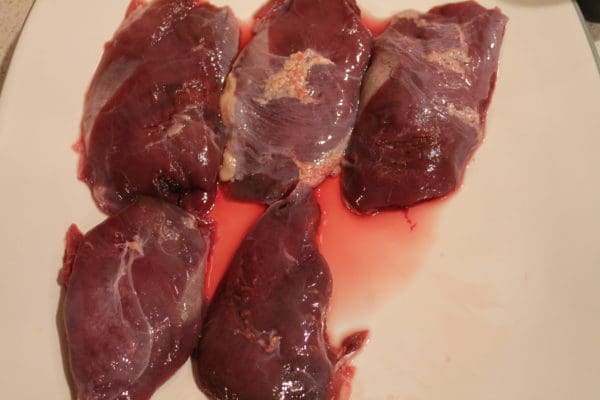
Recipe: Duck Breast Pastrami
Start by thawing your duck breasts in the refrigerator. Keep them there until you’re ready to start preparing. During that time, collect your ingredients.
For the Cure
- 1/4 cup Kosher salt
- 2 teaspoons ground black pepper
- 2 teaspoons ground coriander
- 2 teaspoons dark brown sugar
- 1 teaspoon ground juniper berries
- 3/4 teaspoon pink curing salt (#1)
- 1/2 teaspoon ground ginger
- 1/2 teaspoon granulated garlic
- 1/2 teaspoon dried thyme
- a touch of cardamom
- 1/4 teaspoon cayenne
- 1/2 tsp Colmans mustard
- 1/2 tsp paprika
For the Rub
- 3 tablespoons ground black pepper
- 3 tablespoons ground coriander
- 1.5 tablespoons garlic powder
- a cup of vinegar for dipping
There’s one item on this list that you’re not likely to have on hand — pink curing salt. You can pick it up online from a variety of sellers, but I found both #1 and #2 salts locally at Callahan’s General Store. Yes, it was more expensive. Yes, I had to drive to go get it. But the people are fantastic, and I like to interact with local business when I can.
They also had Tender Quick which my local HEB doesn’t carry. A thorough description of #1 vs #2 curing salts can be found here. Like the author, I generally err on the side of #2 since I only want botulism in the facial wrinkles of those who need it. For this recipe, I used #1 because I knew that I’d be cooking these to temperature and storing them in the refrigerator.
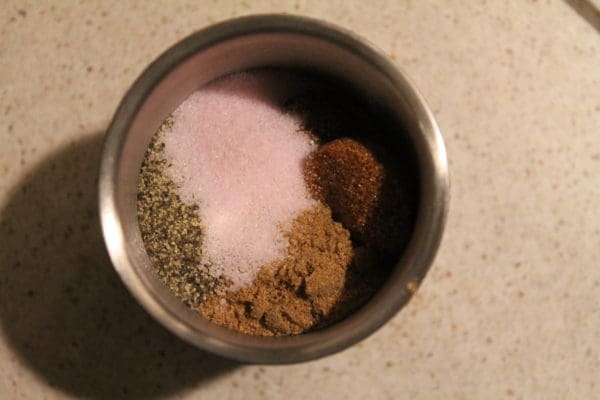
Prepare the cure by mixing all the ingredients. Once mixed, set aside and remove your thawed duck breasts from the refrigerator. Give those luscious breasts a thorough once over. Toss out or carve off any seriously blood shot meat, and remove the silverskin.
Some hunters manage to keep that delicious duck fat in place. I wasn’t so lucky. Once they’re cleaned and prepared, give them a final wash under cold water and remove to a plate.
Generously coat each breast with the cure, placing them in a sealable plastic bag. Once all the breasts have been rubbed down and are at home in the bag, squeeze out the air and place it in the refrigerator. Flip the bag and squish things around every 12 hours for the next three days.
After the curing period has ended, prepare your rub by mixing the three ingredients together. Remove your breasts and wash them under cold running water, removing as much of the cure as you can. Place them in a bowl and fill the bowl with cold water. Change the water every thirty minutes for two hours.
Depending on your smoker, start your heat and smoke at some point during the water bath process. You’ll be targeting a temperature less than 225 degrees with a healthy bit of smoke. I used oak, but feel free to use your favorite.
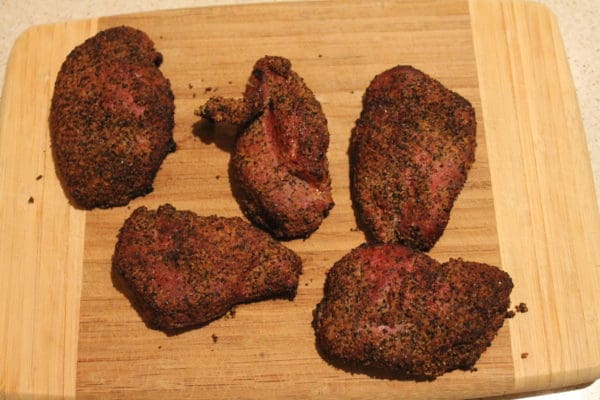
With your smoker at temperature and making tremendous amounts of smoke, remove your breasts from the bowl of cold water, and give them one final wash. Dry them thoroughly, dip them in vinegar, and coat them generously in the rub. Gently shake off any excess and place them in the smoker.
Smoke the breasts until the internal temperature reaches 165 degrees Fahrenheit.
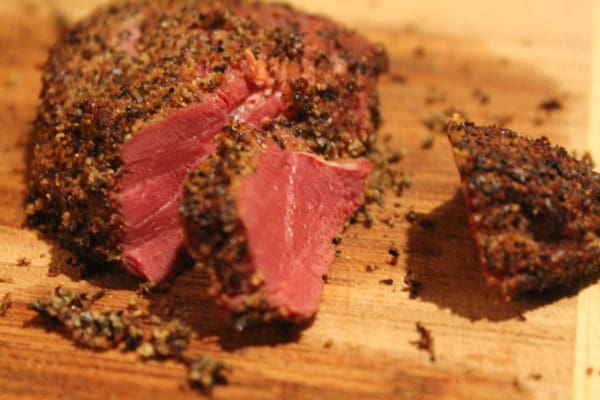
Review
Both recipes I took inspiration from suggested a fairly long smoke time. Mine were done at 37 minutes. I owe this to their relatively small size and my inability to get the temperature of my smoker any lower than 230F. That’s a fine temperature for an all-day pork shoulder, but it runs a little hot for these delicate little breasts. My next iteration will have a heavy focus on keeping the temp around 210 or so.
Slicing into the duck breast, you can see the characteristic pink tone throughout. That lets you know that your cure took hold.
The first bite (and the second, third, and so on) are sublime. There’s no doubt that this is a cured product as there’s a definite salty tang though it’s not overpowering like most jerky. There’s a nice sharp bite from the vinegar with a hot finish from the pepper.
Speaking of jerky, if you’ve ever had “not quite done” jerky, that’s as close as I can approximate in describing the texture. The breasts turned out moist and tender and it was all I had to keep from diving into them right there.
I took one to a coworker who had loaned me some waders for the trip and watched him devour it within a few minutes, stopping only to begrudgingly share some with his manager. He had avoided hunting ducks over saltwater, but said that this method of preparation might give him a reason to head to the coast for more than just red drum.
Ultimately, I was very satisfied with how these turned out, especially given the poor care they got in the field. For future saltwater duck hunting trips, I’ll be sure to get the birds breasted out immediately to avoid any funk.
I’ll also be sure to watch my smoker temperature. Otherwise, I was totally satisfied with the flavor imparted by the various spices and neither my coworker or I fell ill after eating them
Now to go out and find a good spicy mustard recipe.





Well it must be darn tasty to go through all that effort and want to do it all over again which is exactly what the huntin’ side of the family does. Around here lately it’s been Zaterain’s Red Beans and Rice mixed with boiled and sliced Louisiana Hot Links all served with a slab of hot buttered corn bread. 35.5 minutes cook time.
What’s with the heavy handed push for pastrami lately?
That pastrami industry. Next thing ya know they will be telling you that if you eat pastrami you get your ‘man card’ and the anti-pastrami groups will be wanting to sue them out of business.
at least it wasn’t veal pastrami.
“What’s with the heavy handed push for pastrami lately?”
If you thought ‘Big Tech’ was evil, ‘Big Pastrami’ makes them look like pikers.
It’s really just ways to make less-tasty meats taste better, like how BBQ was meats the ‘Massa’ didn’t want, and the slaves made it delicious.
Did you notice a common theme in the preparation? How many times he washed the meat in clean water?
At least you can go fishing for Redfish (red drum), Tyler. They are just starting to reopen the fisheries here in gulf-side Florida, with *severely* reduced bag limits… 🙁
Must be more than Romanians who made Goose Pastrami. I remember my grandfather always complaining that nowhere in Florida knew how to make good pastrami. We took him to Woofies for his birthday one time and he said the green tomatoes and kraut were good but that was a lousy sandwich.
The last duck I shot must have been sick, it wouldn’t fly and tasted like plastic.
Possum, you shot the decoy!
Maybe? Possum. Was it pink with long legs?
And did the legs go all the way up? 🙂
Your thinking about a dance JWM
Shore looks good but too much trouble. I can just order some cow pastrami from local deli. There was a time I would have done this recipe but those years are behind me now.
Basically the same process as beef brisket/skirt/flank pastrami then.
Whether of not a duck is a saltwater species or not make’s no difference to the salt content of the meat. After all the flesh of salt water fish is not salty is it?? A difference in taste will be mostly down to diet and species. But I think that I might just give this a go and I know that Salt Cured and Smoked Whole Duck is a Chinese delicacy.
Bat wings man, Bat wings.
Toasted, roasted, broiled, baked, deep fried, refried , or raw, Bat wings, man, Bat wings
THANKS ON ARTICLE , USE TO HUNT WITH UNCLE MANY YEARS AGO , WAS BEST TIME AND EAT N EVER … HE PASSED ON NOW ,, STILL REMEMBER AND THANKFUL FOR TIME SPENT WITH HIM …
ty, i found this on shaw’s site many years ago. the variation are endless, the basic premise simple.
haven’t bought anything but white trash yellow for the kids since.
https://honest-food.net/how-to-make-mustard-2/
Comments are closed.